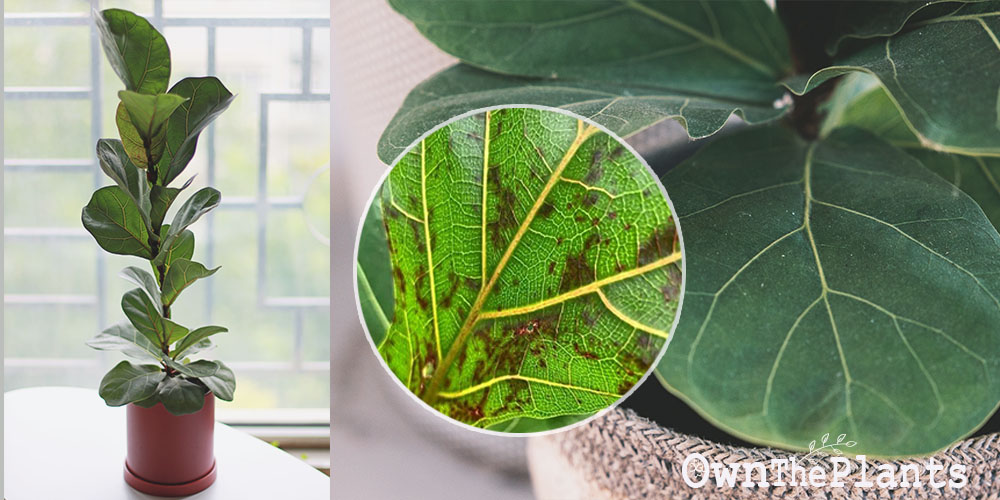Perhaps, there is no more common indoor tree than your Fiddle Leaf Figs, which grows in popularity due to their exotic, premium look coupled with low maintenance care.
However, no matter how easy, owners still commit slight mistakes in caring for them, leading to the development of red spots on their leaves.
But what exactly are these red spots? And what could have been done to avoid them?
In this article, discover these stubborn red spots and how your plants got them, while we also show you how to fix them respectively.
We will also give you tips on how to properly care for your fiddle leaf figs so that you will not have to worry about this problem again.
You might like: Why Are My Chinese Evergreen Leaves Curling? (8 Causes + Fix)
Getting To Know Fiddle Leaf Fig Trees
The fiddle leaf figs, scientifically known as Ficus lyrata, is a famous indoor tree that features a large, veined, fiddle-shaped leaves (hence the name), growing on a sturdy trunk. It is fast growing plant that can be planted at any time of the year.
These indoor trees, also called Banjo Figs, can grow up to 50 feet tall outdoors but only 10 feet tall indoors.
Although they are pretty known indoor plants, precautions must be observed since they can be toxic to pets and kids.
Why Do My Fiddle Leaf Fig Trees Have Red Spots?
The red spots are common problems of fiddle leaf figs that can be from various origins. The most common causes would be edema and spider mites. However, other pest infestations, light exposure, underwatering and bacterial or fungal infections can also cause this problem.
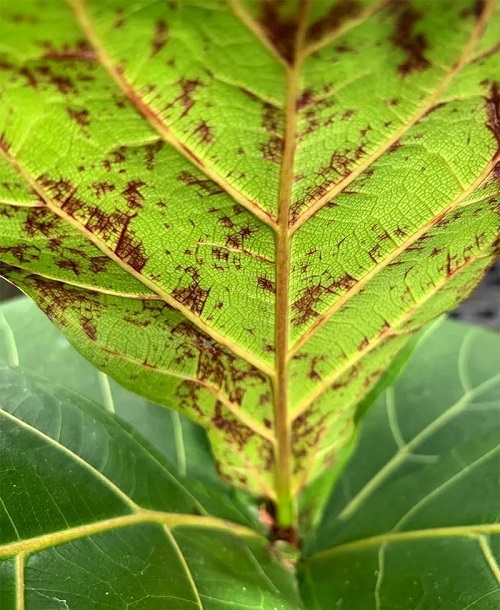
Depending on its cause, this problem can be fixed by so many ways. We list down below the possible causes and, of course, the proper fix to regain the healthy, beautiful leaves of your plant.
Edema
Sometimes spelled as oedema, Edema, is the most common cause of red spots on newly-emerged leaves of fiddle leaf fig trees.
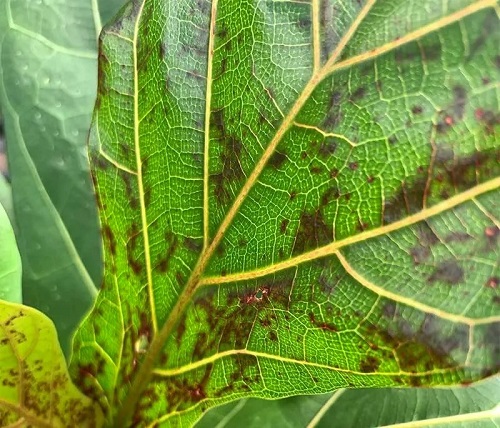
Edema is a plant disorder mainly caused by moisture stress from improper watering. The ficus is known to be prone to this stress.
The formation of edema starts from the plant roots absorbing more water than the leaves of the plant can transpire, hence building pressure inside its body.
The pressure builds up until the cells in the leaves burst. The cells eventually die, manifesting as dark blisters or bruises, 1 to 3 millimeters in size.
This should not cause a serious alarm since edema is common, especially when the plant is in the actively growing phase. This is because actively growing plants need extra water than mature ones.
Edema Fix
Generally, mild edema is totally acceptable unless it causes root rot. But to fix this problem, observing the plant growth cycle is necessary. Increase watering when new sprouts are present and decrease when there are none.
Proper watering is crucial for the plant since underwatering can lead to its own problems.
Since edema is mostly caused by too much water, the red spots will eventually disappear when watering is controlled correctly.
Spider Mites
Another common cause of red spots is spider mites. These plant parasites typically thrive on the downside of the leaves, where they feed on plant cells by rupturing them.
These ruptured cells eventually die, thus leaving red or brown spottings on the surface of the leaves.
These spider mites are tiny organisms, which do not grow over a millimeter in size. They are also hard to detect since they come in different colors to help them adapt to the environment they are in. A thorough inspection is a must.
If you find it hard looking for them, one obvious sign that of their presence is the formation of silk webs. You can use a magnifying glass to detect them.
Spider Mites Fix
Although they can cause serious problems, spider mites are easy to remove. You can remove them easily using a strong pulse of water. This force by water also discards their eggs, hence solving the issue permanently.
However, note that the growth can be stunted permanently if the infestation is extreme. But the red spots will definitely be removed and the leaves will gradually be improved after treating.
False Spider Mites
Aside from spider mites, there are a lot of other parasitic pests that feasts on your fiddle leaf figs.
Some even more difficult to detect like your false spider mites which do not spin the characteristic silky webs.
The formation of red spots is also the same way as those with spide mites. They feed on plant cells by rupturing them, and eventually these ruptured cells die, creating red or brown spots.
False Spider Mites Fix
A magnifying glass is your best friend in detecting these pests. Without silky webs, they are much harder to find. Focus on where the red spots are and disturb them. If you see movement, then it is an unfortunate sign of mite presence.
Remove them using a jet of water, like how you deal with spider mites.
Bacterial or Fungal Infection
Although highly rare, the University of Florida Extension still did not cross out the possibility of bacterial or fungal problems to be the cause of red spots on fiddle leaf figs.
Edema and mites are still the leading causes of the red spot problem. But if your watering is on point and you don’t see any signs of parasite involvement, then you might consider the possibility of infection.
Bacterial or Fungal Infection Fix
A healthy plant can easily curb this problem naturally. However, to help your plant in combatting the infection, you could spray your plant with additional protection. There are many commercially available fungicidal and bacterial sprays that you can use.
If you are into organic fixes, you can use neem oils or other horticultural oils available.
They not only help you fight off the responsible organisms but also make your plants look healthier and their leaves shinier.
Avoid also overwatering your plant and leave excessive moisture behind. Not only does this cause edema, but also, a moist environment is a good thriving place for bacteria and fungi.
The more excessively moist environment your plant in, the more susceptible to diseases.
Underwatering
We presented to you the effects of overwatering, including edema and bacterial and fungal infection. However, underwatering can also be the cause of red spots on your fiddle leaf figs.
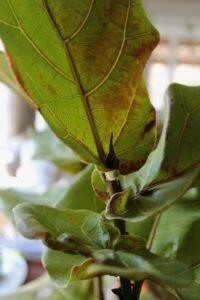
This is a common issue to plant owners once they detect edema on their plants. They restrict watering so much that they forgot to provide enough water to their plants. This most likely causes stress response to plants.
Without water in the soil, the plant roots are not able to absorb essential minerals. This lead to formation of brown or red spots on the leaves. And in extremely worse conditions, even plant death.
Underwatering Fix
Proper watering should slowly regain your plant’s healthy stature. However, proper watering entails knowledge on the requirements of your plant as season changes.
In summer and spring, your fiddle leaf figs require more water than in winter and fall.
More so, as discussed earlier, an actively growing plant also needs more watering than your matured ones.
Keep these in mind and set your watering schedule accordingly!.
Did You Know?
Underwatering Symptoms Vs. Overwatering Symptoms
Determining whether or not the red spots are caused by overwatering or underwatering can be difficult.
Thus, we take the time to list down the differences between the two so that you can easily get to the bottom of the problem and take necessary measures to solve it.
Overwatered Fiddle Leaf Figs
- Red spots are usually located at the center of the leaves and not on edges
- Bottom leaves have red or brown spots first before other leaves
- Bottom leaves are the first to droop and become yellow, followed by other leaves
- Root rotting is the most obvious sign of overwatering. If you see roots turning brown and mushy and has foul smell, then surely you have a problem with overwatering.
Underwatered Fiddle Leaf Figs
- Red spots appear on the edges of the leaves and not on the center
- Red or brown spots appear all over the plant at once, from top to the bottom.
- Leaves anywhere can be droopy and become yellow.
- Dry and cracky soil environment.
As you can see, the main symptoms can be similar with overwatering and underwatering, however there are slight differences that can help you take the right course of actions and not make the problem worse.
The key to every plant problem is keen observation.
Over Light Exposure
Sunburns may seem foreign to plants but it happens to them. Although sunburn is not the usual cause of red spots on fiddle leaf figs, it is not impossible. As they all say, too much of everything will never be good.
Fiddle leaf figs require bright environments to maintain healthy and grow as fast as they can. However, direct sunlight is a no-no.
If they are left for too long under extreme UV, bleachy spots on the leaves will start to appear. They can be red, white, or brown spots.
Over Light Exposure Fix
The affected leaves of extreme light exposure could not be saved and will only be a liability to the plant, hence it is best to prune them off.
Find another location for your plant where it is equally bright but has no direct sunlight. Relocate your plant there and soon enough it will thrive again.
Final Thoughts
Fiddle leaf fig trees are indeed beautiful house plants that make every space premium and more lively.
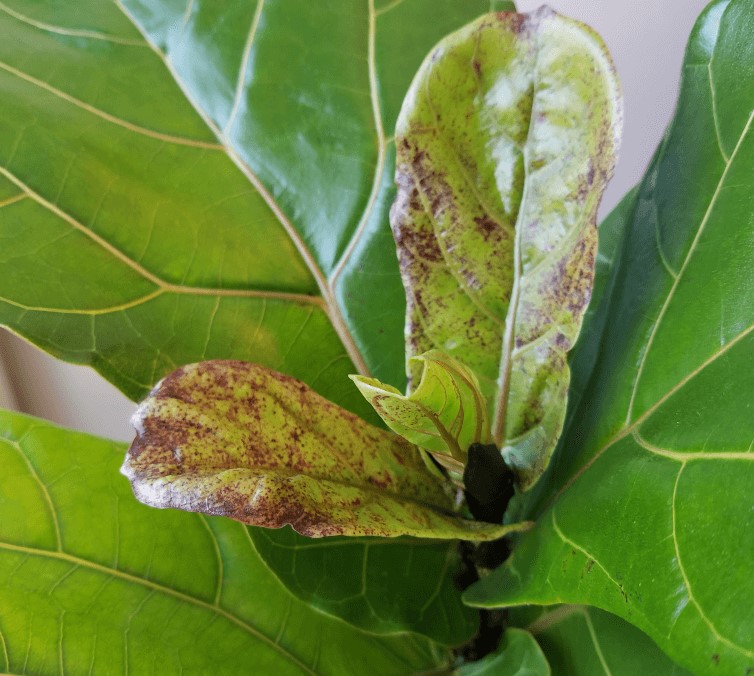
But of course, it is inevitable that your plants get sick every once in a while. Understanding what your plant needs is a must for all plant owners.
The red spots of fiddle leaf Figs can be due to various factors, such as bacterial or fungal infection and direct light exposure, but edema and pest infestations are the leading causes.
It is imperative that you know the proper cause of the problem so that you can take the right actions to mitigate it.
There is nothing that a plant lover wants than beautiful, healthy, thriving plants in their own spaces. But it’s not all the time that you get all that you want, right?
In the plant community, it is more common to commit mistakes in plant caring than you ever think of. So don’t punish yourself if every once in a while, your plant is not at its best.
We would like to hear from your experiences with fiddle leaf fig trees in the comment section below. Feel free to drop anything there. May you grow forth with your plants!
Photo by Amelia Cui/ Lachlan Ross.
